Enjoying the content on 3QD? Help keep us going by donating now.
Category: Recommended Reading
A historian’s perspective on “Original Sin: President Biden’s Decline…”
Richard Aldous at Persuasion:
 Public gaffes piled up. Biden referred to Vice President Harris as “Vice President Trump” and described himself as the first black vice president. At a NATO summit President Zelensky of Ukraine was called “President Putin.” Behind the scenes at photo ops Biden would regularly fail to recognize long-time friends and colleagues. Even George Clooney, not a man used to being ignored, went unrecognized at a Hollywood fundraiser that he himself had organized. At campaign events Biden would repeat stories or simply allow them to peeter out into an embarrassed silence. He would lose his way coming off stage. His voice, hoarse at the best of times, would often become an inaudible whisper.
Public gaffes piled up. Biden referred to Vice President Harris as “Vice President Trump” and described himself as the first black vice president. At a NATO summit President Zelensky of Ukraine was called “President Putin.” Behind the scenes at photo ops Biden would regularly fail to recognize long-time friends and colleagues. Even George Clooney, not a man used to being ignored, went unrecognized at a Hollywood fundraiser that he himself had organized. At campaign events Biden would repeat stories or simply allow them to peeter out into an embarrassed silence. He would lose his way coming off stage. His voice, hoarse at the best of times, would often become an inaudible whisper.
Meanwhile the decision-making process in the Oval Office became more and more opaque. “The thing is, he’s an old man,” said one cabinet secretary interviewed for the book. “His guard was down [and] I think people around him had their own agenda.”
But anyone who said so at the time found themselves subject to the full force of the White House operation, led by the “Politburo” of advisers like Mike Donilon, Steve Ricchetti, and Anita Dunn.
More here.
Enjoying the content on 3QD? Help keep us going by donating now.
Uncovering Jack Whitten’s Mysterious Abstractions
Enjoying the content on 3QD? Help keep us going by donating now.
Thursday Poem
This Minute, This Life
However hard I try
to forget what I’ve learned
to not know what I know
to not see, not believe
sudden doors open anyway
to moments of clarity
to lost treasure found
and fingers of light pointing
this leaf, this word,
this minute, this life.
by Johanna Jordan
from Small Poems, 2006
Enjoying the content on 3QD? Help keep us going by donating now.
Jack Whitten: The Messenger
Clifford Thompson at Commonweal:
 Why abstract art? The question is not rhetorical, especially as a point of entry into the visionary work of Jack Whitten, whose career spanned six decades before he died in 2018. One possible answer: the need to say what cannot be said according to the usual rules—rules for perspective, light, scale, and all the rest, but also, and maybe most importantly, rules for representing the world in a way that the world has already recognized. What looks real, what is real, may not be the same for you as it is for me. That makes it vitally important for artists to paint, sculpt, or draw the world as they see it, regardless of the rules. And that is particularly true when the rules—inside the world of art schools, galleries, and museums and, most especially, outside it—constitute the very evil that makes their work necessary.
Why abstract art? The question is not rhetorical, especially as a point of entry into the visionary work of Jack Whitten, whose career spanned six decades before he died in 2018. One possible answer: the need to say what cannot be said according to the usual rules—rules for perspective, light, scale, and all the rest, but also, and maybe most importantly, rules for representing the world in a way that the world has already recognized. What looks real, what is real, may not be the same for you as it is for me. That makes it vitally important for artists to paint, sculpt, or draw the world as they see it, regardless of the rules. And that is particularly true when the rules—inside the world of art schools, galleries, and museums and, most especially, outside it—constitute the very evil that makes their work necessary.
That was certainly true for Whitten, the African American son of a coal miner and a seamstress, born in 1939 and raised in segregated Bessemer, Alabama. Here is how segregated: Whitten and other Black students were prohibited from visiting art museums, so they toured the area’s coal mines and steel mills instead. The first member of his family to attend college, Whitten became a premed student at Alabama’s Tuskegee Institute before shifting his focus in 1959—ironically, given the restrictions placed on him during boyhood—to art.
more here.
Enjoying the content on 3QD? Help keep us going by donating now.
The Levellers
Rowan Wilson at Aeon Magazine:
 In April 1649, the earth of St George’s Hill in Surrey, England, was disturbed. A group of men and women calling themselves the ‘True Levellers’, known to history as the ‘Diggers’, had taken to the ‘wast[e] ground’ in the parish of Walton to protest enclosure, the process by which common land was parcelled into units of private property, stripping commoners of their traditional rights of access and usage. The land was bad – ‘nothing but a bare heath & sandy ground’, surveyors reported in 1650 – but the Diggers believed it could be made fruitful.
In April 1649, the earth of St George’s Hill in Surrey, England, was disturbed. A group of men and women calling themselves the ‘True Levellers’, known to history as the ‘Diggers’, had taken to the ‘wast[e] ground’ in the parish of Walton to protest enclosure, the process by which common land was parcelled into units of private property, stripping commoners of their traditional rights of access and usage. The land was bad – ‘nothing but a bare heath & sandy ground’, surveyors reported in 1650 – but the Diggers believed it could be made fruitful.
Over the coming weeks and months, they husbanded the earth, composting burnt turf, digging parsnips, planting carrots and beans. They even built cottages. Many knew the land well: the historian John Gurney estimated that about a third of the Diggers were local inhabitants. Their choice to join the Digger project was likely informed by years of local struggle: conflict with landlords, heavy Civil War taxation, the burdensome passage of troops through villages. But the object of their protest – enclosure – was hardly an issue confined to Walton: over several centuries, landowners across England had become ever more hungry to expropriate the commons from the commoners.
more here.
Enjoying the content on 3QD? Help keep us going by donating now.
Elon Musk Bought a Website. What He Got Was a Bot-Training Machine
Alex Kirshner in Slate:
 Through a stroke of good fortune, Elon Musk’s otherwise disastrous purchase of Twitter has turned into one of the great business acquisitions of all time. Buying control of a president was a start. What if the deal bought him something even more valuable?
Through a stroke of good fortune, Elon Musk’s otherwise disastrous purchase of Twitter has turned into one of the great business acquisitions of all time. Buying control of a president was a start. What if the deal bought him something even more valuable?
Musk’s purchase of Twitter, which closed in the fall of 2022, has undergone an odyssey. It was clear from the moment Musk made the deal that it was a terrible idea, on business terms. (“Elon Musk Just Impulse-Bought a $44 Billion Pain in the Ass,” our headline read.) Musk realized that soon enough and tried to nuke the deal with specious arguments about bots and mismanagement. When he finally relented, Musk was stuck with a money-losing property. The company’s prospects were so bad that the banks that loaned Musk billions couldn’t even off-load the debt. Nobody wanted to own a piece of a car fire.
More here.
Enjoying the content on 3QD? Help keep us going by donating now.
Debunking Dangerous Views of Autism
Lina Zeldovich in Nature:
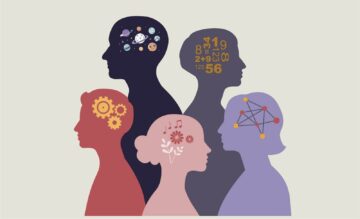 Autism spectrum disorder, or autism, is a neurodevelopmental disorder. People with the disorder may have deficits in social communication and interaction and restricted and repetitive patterns of behavior, interests, or activities. Autism is really a construct, an idea that there is something different about people who have very basic deficits or difficulties in social communication, starting very young, and also certain repetitive or sensory differences compared to neurotypical people.
Autism spectrum disorder, or autism, is a neurodevelopmental disorder. People with the disorder may have deficits in social communication and interaction and restricted and repetitive patterns of behavior, interests, or activities. Autism is really a construct, an idea that there is something different about people who have very basic deficits or difficulties in social communication, starting very young, and also certain repetitive or sensory differences compared to neurotypical people.
Autism is probably present before birth, and it affects development. Even if someone doesn’t get a diagnosis very early, it means that you process information from the world differently, and you will be affected differently by your experiences. Some people with autism are better at certain things than neurotypical people, but they might also be worse than neurotypical people at other things. Finally, autism is different in a 2-year-old than in a 40-year-old, even though the basic condition is still the same.
More here.
Enjoying the content on 3QD? Help keep us going by donating now.
Wednesday, May 28, 2025
The Bourgeois Morality of ‘The Ethicist’
Alex Skopic, Lily Sánchez & Nathan J. Robinson at Current Affairs:
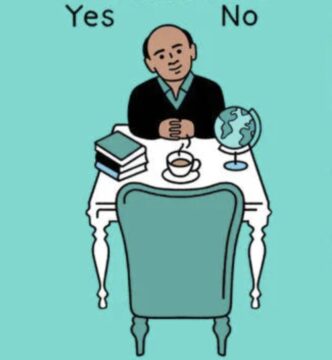 The term “first-world problem” is used to describe the type of minor nuisance that occupies the minds of the bourgeoisie. You dropped an AirPod in the urinal. You spilled chardonnay on the divan. Whole Foods was out of pomegranates. And so forth. These are perfectly real frustrations, but they only afflict the comfortable. We might define a parallel quandary in the field of moral philosophy: the first-world ethical problem. These are dilemmas about right and wrong that don’t actually touch any of the major ethical crises of our time or issues of structural injustice. They’re problems that only arise or seem worthy of spending time on once you reach a certain level of wealth and privilege. The New York Times advice column, The Ethicist, is filled with these kinds of bourgeois dilemmas.
The term “first-world problem” is used to describe the type of minor nuisance that occupies the minds of the bourgeoisie. You dropped an AirPod in the urinal. You spilled chardonnay on the divan. Whole Foods was out of pomegranates. And so forth. These are perfectly real frustrations, but they only afflict the comfortable. We might define a parallel quandary in the field of moral philosophy: the first-world ethical problem. These are dilemmas about right and wrong that don’t actually touch any of the major ethical crises of our time or issues of structural injustice. They’re problems that only arise or seem worthy of spending time on once you reach a certain level of wealth and privilege. The New York Times advice column, The Ethicist, is filled with these kinds of bourgeois dilemmas.
More here.
Enjoying the content on 3QD? Help keep us going by donating now.
Coercive Cooperation: Forcing Win-Win Outcomes in an AI-driven Transition
Eric Drexler at AI Prospects: Toward Global Goal Alignment:
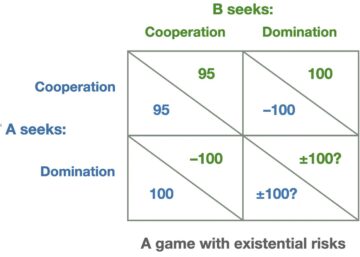 Advanced AI will transform possibilities, and our future will depend on which become real. Deep uncertainties make an AI arms race risky for all sides, yet AI also creates opportunities for unprecedented security. The key challenge isn’t technical feasibility — advanced AI can do that heavy lifting — but navigating from competition to cooperation against the friction of reality: institutional inertia, expectations rooted in thousands of years of state conflict, and sheer failure to recognize unprecedented options.
Advanced AI will transform possibilities, and our future will depend on which become real. Deep uncertainties make an AI arms race risky for all sides, yet AI also creates opportunities for unprecedented security. The key challenge isn’t technical feasibility — advanced AI can do that heavy lifting — but navigating from competition to cooperation against the friction of reality: institutional inertia, expectations rooted in thousands of years of state conflict, and sheer failure to recognize unprecedented options.
Consider the fundamental strategic choices facing great powers in an AI-enabled world. Each side can pursue either cooperation (seeking defensive stability) or domination (seeking offensive superiority). In a world of profound AI-driven uncertainty strategic calculations cannot be carefully weighed, hence the pursuit of deterrence — peace through strength — in practice becomes indistinguishable from pursuit of offensive superiority. This suggests four possible scenarios, which we can represent as a stylized payoff matrix incorporating uncertainty.
More here.
Enjoying the content on 3QD? Help keep us going by donating now.
Redefining Robotics with Carolina Parada
Enjoying the content on 3QD? Help keep us going by donating now.
The modern education system around the world continues to bear the imprint of mass education’s original goal: obedience
Agustina Paglayan at Asterisk:
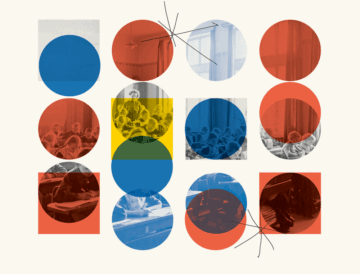 Clara Collier: To start, do you want to give us a quick background of the book and your research?
Clara Collier: To start, do you want to give us a quick background of the book and your research?
Agustina Paglayan: Sure. Raised to Obey examines the origins of modern public education systems. This project began out of my interest in our current education systems and why, in many different countries, they are not living up to their promise of leveling the playing field, of giving people the knowledge and skills they need to thrive.
In seeking to understand that problem, I realized that I had to go back in time to understand why these education systems were established in the first place. Were they created and designed to teach kids valuable knowledge and skills, or were they designed with a different set of goals in mind? And what I learned was that they were actually designed with a different goal. The primary purpose behind the creation of primary education systems was to convert unruly children into obedient citizens who would respect the state and its laws.
The idea that rulers had was that if you caught children from a young age and taught them to sit still, to respect rules, to respect the teacher’s authority, they were going to internalize these norms — that following rules and respecting authority is a good thing to do. And in the long term, that would lead to social order and political stability that would preserve the status quo, which these rulers benefited from.
More here.
Enjoying the content on 3QD? Help keep us going by donating now.
The Orb Will See You Now
Billy Perrigo in Time Magazine:
 Once again, Sam Altman wants to show you the future. The CEO of OpenAI is standing on a sparse stage in San Francisco, preparing to reveal his next move to an attentive crowd. “We needed some way for identifying, authenticating humans in the age of AGI,” Altman explains, referring to artificial general intelligence. “We wanted a way to make sure that humans stayed special and central.”
Once again, Sam Altman wants to show you the future. The CEO of OpenAI is standing on a sparse stage in San Francisco, preparing to reveal his next move to an attentive crowd. “We needed some way for identifying, authenticating humans in the age of AGI,” Altman explains, referring to artificial general intelligence. “We wanted a way to make sure that humans stayed special and central.”
The solution Altman came up with is looming behind him. It’s a white sphere about the size of a beach ball, with a camera at its center. The company that makes it, known as Tools for Humanity, calls this mysterious device the Orb. Stare into the heart of the plastic-and-silicon globe and it will map the unique furrows and ciliary zones of your iris. Seconds later, you’ll receive inviolable proof of your humanity: a 12,800-digit binary number, known as an iris code, sent to an app on your phone. At the same time, a packet of cryptocurrency called Worldcoin, worth approximately $42, will be transferred to your digital wallet—your reward for becoming a “verified human.”
More here.
Enjoying the content on 3QD? Help keep us going by donating now.
John Koethe: The Self in Oscillation
Enjoying the content on 3QD? Help keep us going by donating now.
It’s the Secret Doctors Keep from You
Rahul Parikh in Nautilus:
 Uncertainty is something we hide from in medicine. As doctors, we exist to make things certain for our patients. We call it a diagnosis. We hone our skills and carry a toolbox of tests to provide it. And then we prescribe drugs to treat it. When we meet uncertainty we cannot overcome, we get ill at ease. We grapple with uncertainty like a psychic beast in our minds and often hide it from our patients and colleagues. We know our patients are often torn with uncertainty about symptoms and what to do about them, but we’re not very good at talking to them about uncertainty. Medical school teaches us to put on a confident face. It doesn’t cover how to treat the symptoms of doubt.
Uncertainty is something we hide from in medicine. As doctors, we exist to make things certain for our patients. We call it a diagnosis. We hone our skills and carry a toolbox of tests to provide it. And then we prescribe drugs to treat it. When we meet uncertainty we cannot overcome, we get ill at ease. We grapple with uncertainty like a psychic beast in our minds and often hide it from our patients and colleagues. We know our patients are often torn with uncertainty about symptoms and what to do about them, but we’re not very good at talking to them about uncertainty. Medical school teaches us to put on a confident face. It doesn’t cover how to treat the symptoms of doubt.
Emily Silverman, creator and host of the medical podcast The Nocturnists, has been thinking deeply about uncertainty. Silverman is an internal medicine doctor and an assistant professor of medicine at the University of California, San Francisco. Earlier this year, The Nocturnists launched a 13-part series, “Uncertainty in Medicine,” featuring stories from frontline doctors, medical students, patients, and a broad array of others, to bring the topic of uncertainty into the open.
More here.
Enjoying the content on 3QD? Help keep us going by donating now.
Wednesday Poem
The First Words
(from the Romanian of Marin Sorescu)
The first words got polluted
Like river water in the morning
Flowing with the dirt
Of blurbs and the front pages.
My only drink is meaning from the deep brain,
What the birds and the grass and the stones drink.
Let everything flow
Up to the four elements,
Up to water and earth and fire and air.
by Seamus Heaney
from The Spirit Level
Farrar Straus Giroux, NY, 1996
Enjoying the content on 3QD? Help keep us going by donating now.
The Private Language Of John Koethe
Barry Schwabsky at The Point:
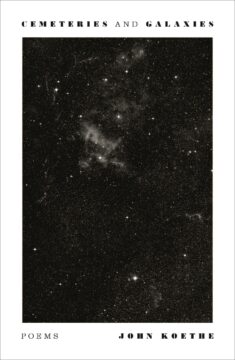 Koethe’s taste for self-contradiction or self-revision, and for rambling free-associative structures of “meditation gone awry” (as he puts it in the poem “Naturalism”) that move around in strange eddies before circling back to some revised perception of their starting point, may seem surprising in a poet whose day job has been in a philosophy department, where logical consistency and a rigorous organization of argument are valued. But then this is the philosopher-poet who once proclaimed, flatly, “I don’t like poems about philosophy.” His poetry seems to be the place for everything philosophy doesn’t know what to do with, for what in “Against Materialism” he calls, “Things so commonplace it’s easy to forget how strange they are” but which “Make up the furniture of the world, and if none of them pass muster metaphysically, / So what?”
Koethe’s taste for self-contradiction or self-revision, and for rambling free-associative structures of “meditation gone awry” (as he puts it in the poem “Naturalism”) that move around in strange eddies before circling back to some revised perception of their starting point, may seem surprising in a poet whose day job has been in a philosophy department, where logical consistency and a rigorous organization of argument are valued. But then this is the philosopher-poet who once proclaimed, flatly, “I don’t like poems about philosophy.” His poetry seems to be the place for everything philosophy doesn’t know what to do with, for what in “Against Materialism” he calls, “Things so commonplace it’s easy to forget how strange they are” but which “Make up the furniture of the world, and if none of them pass muster metaphysically, / So what?”
That doesn’t mean Koethe forbears to mention or quote philosophers classical (Kant, Hume, Berkeley) or contemporary (Donald Davidson, Derek Parfit and “the greatest moral philosopher since Kant,” as he calls the eponymous subject of the poem “John Rawls et al.”), discuss familiar philosophical themes and topics—appearance vs. reality, the existence of God (he doesn’t buy it, though his upbringing was religious)—or recount episodes from his professional life in philosophy, such as the doctoral defense in which Rawls dismissed one of the other examiners’ objections and then invited the young Koethe for a drink, “which I declined.”
more here.
Enjoying the content on 3QD? Help keep us going by donating now.
The Matter of Martin Amis
Lora Kelley at the Paris Review:
 Amis’s writing is stylish and screwy and grotesque and vulgar. The jokes come at an unhinged pace. He was an exquisite writer of the male body and the horrors of inhabiting one: “My hair hung on my head as if it were a cut-price toupée,” Charles Highway (Charles Highway!) reflects in Amis’s debut novel The Rachel Papers. That same character savages the “Big Boys” that are his pimples and speaks of “laundering my orifices,” as “they went all to hell if not scrupulously maintained.” A genital region is referred to as a “rig.” The names, across his books, are insane. Amis calls characters things like Spunk, 13, Fart Klaeber, Sod. A female cop (or as she calls herself “a police”) is named Mike Hoolihan. A quartet of violent dogs are Joe, Joel, Jeff, and Jon. That he called a writer-character Martin Amis, or so the story goes, caused his father to throw Money across the room. Famed for his antic satire, he was later unafraid to take on—in his novels, nonfiction, and short stories—genocide and the end of the world, too.
Amis’s writing is stylish and screwy and grotesque and vulgar. The jokes come at an unhinged pace. He was an exquisite writer of the male body and the horrors of inhabiting one: “My hair hung on my head as if it were a cut-price toupée,” Charles Highway (Charles Highway!) reflects in Amis’s debut novel The Rachel Papers. That same character savages the “Big Boys” that are his pimples and speaks of “laundering my orifices,” as “they went all to hell if not scrupulously maintained.” A genital region is referred to as a “rig.” The names, across his books, are insane. Amis calls characters things like Spunk, 13, Fart Klaeber, Sod. A female cop (or as she calls herself “a police”) is named Mike Hoolihan. A quartet of violent dogs are Joe, Joel, Jeff, and Jon. That he called a writer-character Martin Amis, or so the story goes, caused his father to throw Money across the room. Famed for his antic satire, he was later unafraid to take on—in his novels, nonfiction, and short stories—genocide and the end of the world, too.
No one is doing it like Amis did. That the contemporary fiction landscape lacks his flavor of frenzied humor, chaotic storylines, maximalist characters, and full-throated play is a loss. But perhaps that’s how it should be, especially for a critic who championed writers whose work could not be mistaken for anyone’s but their own. He was an influence—the 92nd Street Y is planning more events featuring young writers affected by Amis—but he was also singular.
more here.
Enjoying the content on 3QD? Help keep us going by donating now.
Tuesday, May 27, 2025
Adam Tooze: What fires burned at Auschwitz? On the place of the Holocaust in uneven and combined development
Adam Tooze at Chartbook:
 In 1944 after the liberation of Majdanek, where the soviet troops discovered warehouses of shoes and human hair, the term “death factory” gained general currency. Through wartime propaganda channels the Soviet pamphlet, Majdanek the death factory near Lublin by Konstantin Simonov acquired a circulation in the West. In the exhibitionary complex of the holocaust, the shoes from the Majdanek warehouse have become another icon, especially since a large collection of them were donated to the Holocaust memorial museum in Washington DC.
In 1944 after the liberation of Majdanek, where the soviet troops discovered warehouses of shoes and human hair, the term “death factory” gained general currency. Through wartime propaganda channels the Soviet pamphlet, Majdanek the death factory near Lublin by Konstantin Simonov acquired a circulation in the West. In the exhibitionary complex of the holocaust, the shoes from the Majdanek warehouse have become another icon, especially since a large collection of them were donated to the Holocaust memorial museum in Washington DC.
As the researcher Joachim Neander showed in his remarkable essay – “”Seife aus Judenfett” – Zur Wirkungsgeschichte einer Urban Legend” – the soap myth is itself an instance of the conceptualization of the Holocaust as industrialism. The idea that the Germans turned their victims into soap originated in fact in the generation before the Holocaust in a fearful rumor that began to circulate at the end of World War I. As the economic situation of Wilhelmine Germany became desperate and POW along with Germans began to starve, rumors began to circulate that the Kaiser’s regime was rendering the bodies of Belgian and other prisoners of war to make soap.
More here.
Enjoying the content on 3QD? Help keep us going by donating now.
Computer scientist’s “stunning” proof is the first progress in 50 years on one of the most famous questions in computer science
Ben Brubaker in Quanta:
 One July afternoon in 2024, Ryan Williams(opens a new tab) set out to prove himself wrong. Two months had passed since he’d hit upon a startling discovery about the relationship between time and memory in computing. It was a rough sketch of a mathematical proof that memory was more powerful than computer scientists believed: A small amount would be as helpful as a lot of time in all conceivable computations. That sounded so improbable that he assumed something had to be wrong, and he promptly set the proof aside to focus on less crazy ideas. Now, he’d finally carved out time to find the error.
One July afternoon in 2024, Ryan Williams(opens a new tab) set out to prove himself wrong. Two months had passed since he’d hit upon a startling discovery about the relationship between time and memory in computing. It was a rough sketch of a mathematical proof that memory was more powerful than computer scientists believed: A small amount would be as helpful as a lot of time in all conceivable computations. That sounded so improbable that he assumed something had to be wrong, and he promptly set the proof aside to focus on less crazy ideas. Now, he’d finally carved out time to find the error.
That’s not what happened. After hours of poring over his argument, Williams couldn’t find a single flaw.
“I just thought I was losing my mind,” said Williams, a theoretical computer scientist at the Massachusetts Institute of Technology. For the first time, he began to entertain the possibility that maybe, just maybe, memory really was as powerful as his work suggested.
More here.
Enjoying the content on 3QD? Help keep us going by donating now.
